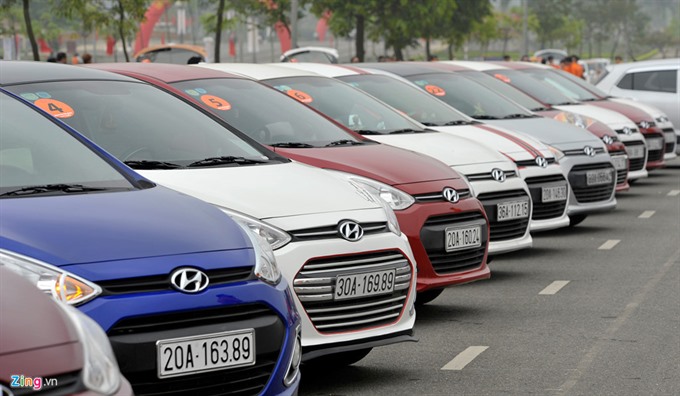 Society
Society

It’s been more than two weeks since Hà Nội began applying higher parking fees, up by 50 to 300 per cent over the previous rates.
 |
Hồng Minh
It’s been more than two weeks since Hà Nội began applying higher parking fees, up by 50 to 300 per cent over the previous rates.
The rationale provided was to discourage the use of private vehicles, thus reducing traffic congestion.
Notice any difference?
No. Nothing that can be discerned on the road, where status quo rules, delivering its usual bedlam in increasing doses.
But there is a discernible difference for private vehicle owners, especially those with cars, who are hit hardest by the fee hike.
When commuters returned to work in the city centre on January 2, after the New Year holiday, realisation dawned quickly that the parking fees for cars had skyrocketed.
For under-nine-seat cars in the core area (around Hoàn Kiếm Lake), the fees have gone up from VNĐ20,000 per hour to VNĐ30,000. A monthly parking lot in this area costs VNĐ3-4 million ($133-177). Parking on other streets inside the Ring Road 1 costs VNĐ50,000 ($2.2) for the first two hours, VNĐ70,000 ($3.1) for the next two, and VNĐ45,000 ($2) for each hour after the fifth hour.
The new rates will have a salaried person pay VNĐ300,000-400,000 ($13-17) for parking for a eight-hour working day. Do the math. How much is that for a working month?
People have no choice in the matter, except to pay the higher fees as of January 1, following the decision signed by Hà Nội People’s Committee Chairman Nguyễn Đức Chung, which, in turn, followed the outcome of a meeting of the city’s People’s Council last month.
Every time the authorities discuss measures to reduce traffic congestion, the solution that stands foremost seems to be an increase in fees on personal vehicles. At the recent meeting of the city People’s Council, it was stressed that the parking fees in Hà Nội were much lower than other cities in the region, giving ample room for an increase. This is true, but it is not the whole story.
Let’s compare Hà Nội to Singapore or Jakarta. For eight hours’ parking, drivers in Singapore may have to pay an average of $72, while drivers in Jakarta may pay around $3. Meanwhile in Hà Nội, drivers are paying $15 or thereabouts. Meanwhile, the per capita income for these two countries in the region stands at over $52,000 for Singapore and nearly $3,900 for Indonesia. In Việt Nam, the figure is only nearly $1,800.
And what do we get for the higher parking fees?
TINA, TINA
Let us consider some Asian cities where parking fees are very, very high, like Tokyo, Hong Kong and Singapore. What are the alternative ways of getting around, especially for commuters at work? Commuting in such cities is easy, because they have very efficient public systems of buses, subway, trains, MRT and so on. So, without private cars, people have a bunch of other convenient options. Everybody seems happy with that, and understandably so.
What do we have in Hà Nội? The only public transport option now is the bus, which is not very convenient and hardly punctual during peak hours. The 10 urban railway projects are slated to open to traffic as far away as 2030.
So, car owners in Hà Nội, who have to pay an average of VNĐ3-5 million a month for fuel, taxes and fees right now, still have to commute and get to work. What choice do they have? If they leave their cars at home and shift to Uber, Grab or taxis, will traffic congestion reduce and their lives become more convenient?
According to the Department of Transport, Hà Nội has more than five million motorcycles and 500,000 cars of all kinds. The average growth rate of automobiles is 10.2 per cent and motorcycles are 6.7 per cent every year.
It is forecast that the number of personal vehicles will increase in the coming time. Specifically, by 2020, the number of cars will increase to 843,000, in 2025 it will be 1.45 million cars and 2030 will be two million cars.
When authorities want to promote the auto industry, people are going to buy more cars. If they want to discourage people from using the cars often, they should ensure that the commuters have viable alternatives.
But, for now, TINA (there is no alternative).
I have my own car. I used to accept a daily parking fee at the workplace of VNĐ100,000 ($4.5), waiting eagerly for the completion of an urban railway project that would connect my house, off the Ring Road 3, to my office in the city centre. I kept saying I would immediately shift to taking the train to work. It would be cheaper and more convenient, of course. But the project has been delayed again and again and again.
Of late, I have shifted to taking buses and app-based services like Uber and Grab, in order to avoid the hassle of finding and paying for parking. But buses, as I mentioned earlier, are inconvenient and not punctual; and while Uber and Grab are just like using private vehicles.
In effect, the decision to increase parking fees has been taken without sufficient research and consideration for public convenience.
Before increasing parking fees or taking other decisions that will inconvenience the general public, authorities should offer commuters other choices, viz., by developing an efficient public transport network as quickly as possible. Work on the planned subway, railway and bus networks should be accelerated. The space for walking and biking should also be expanded so that people have more choices.
Without this, any step taken that inconveniences the public is unreasonable and unfair.
The message for the authorities is simple: If you want us to move (from one form of transport to another), you should get a move on. — VNS




